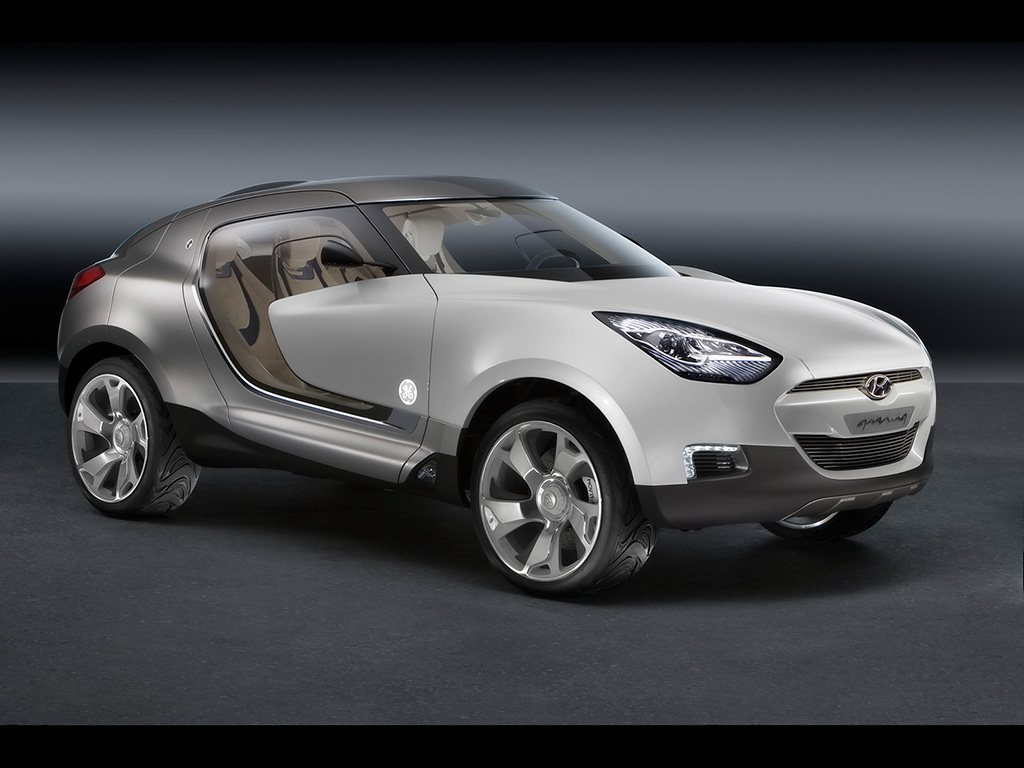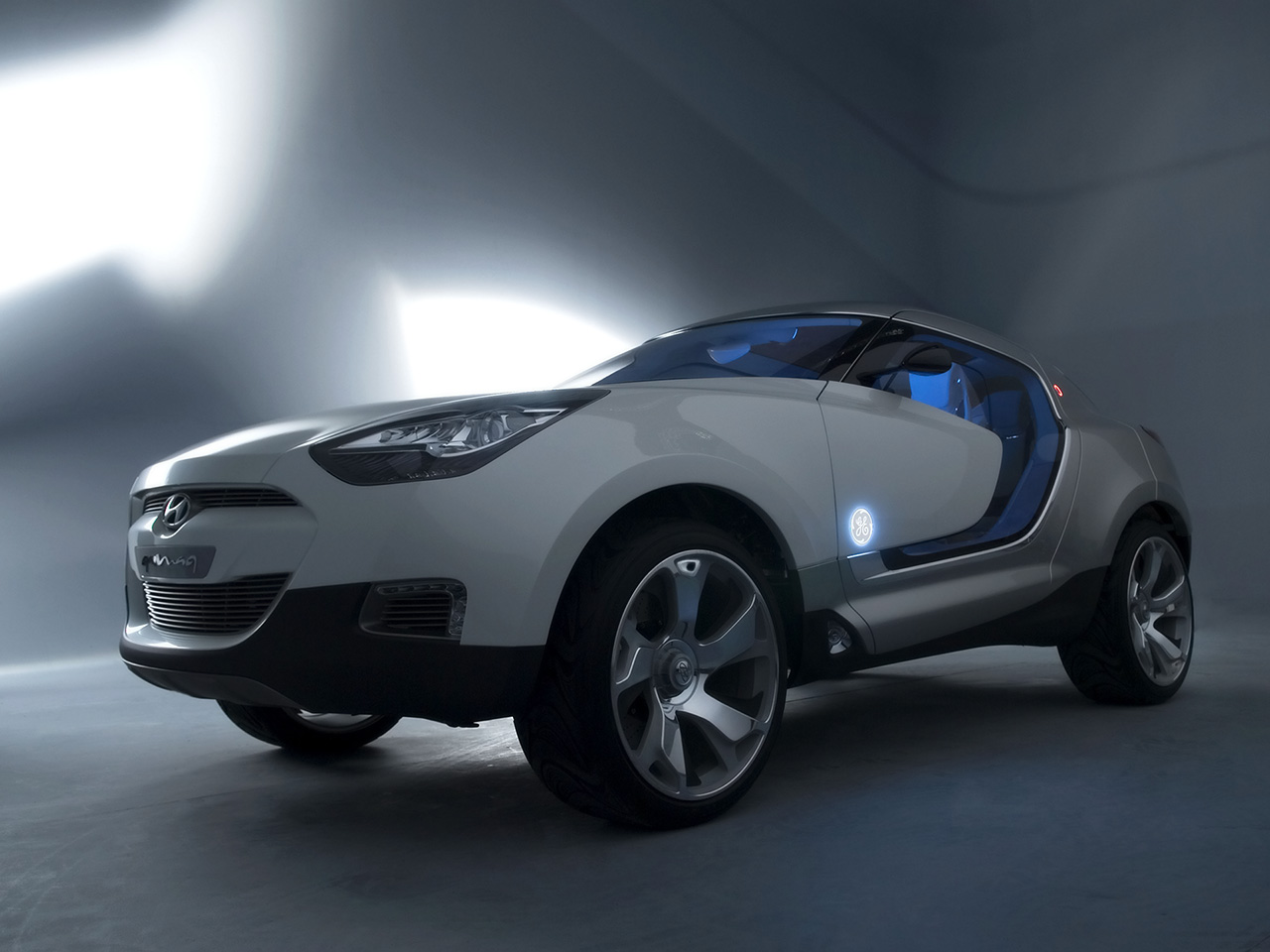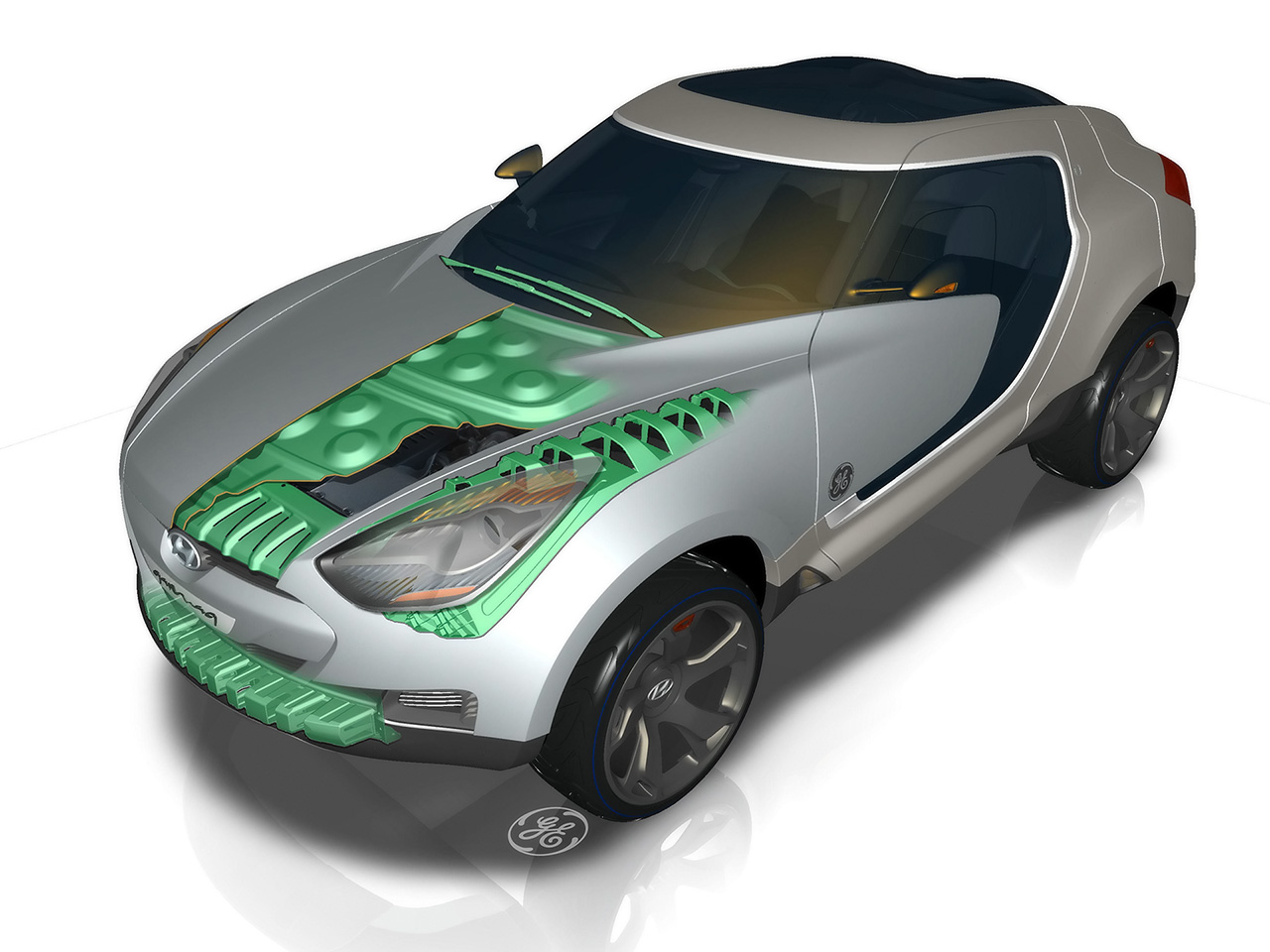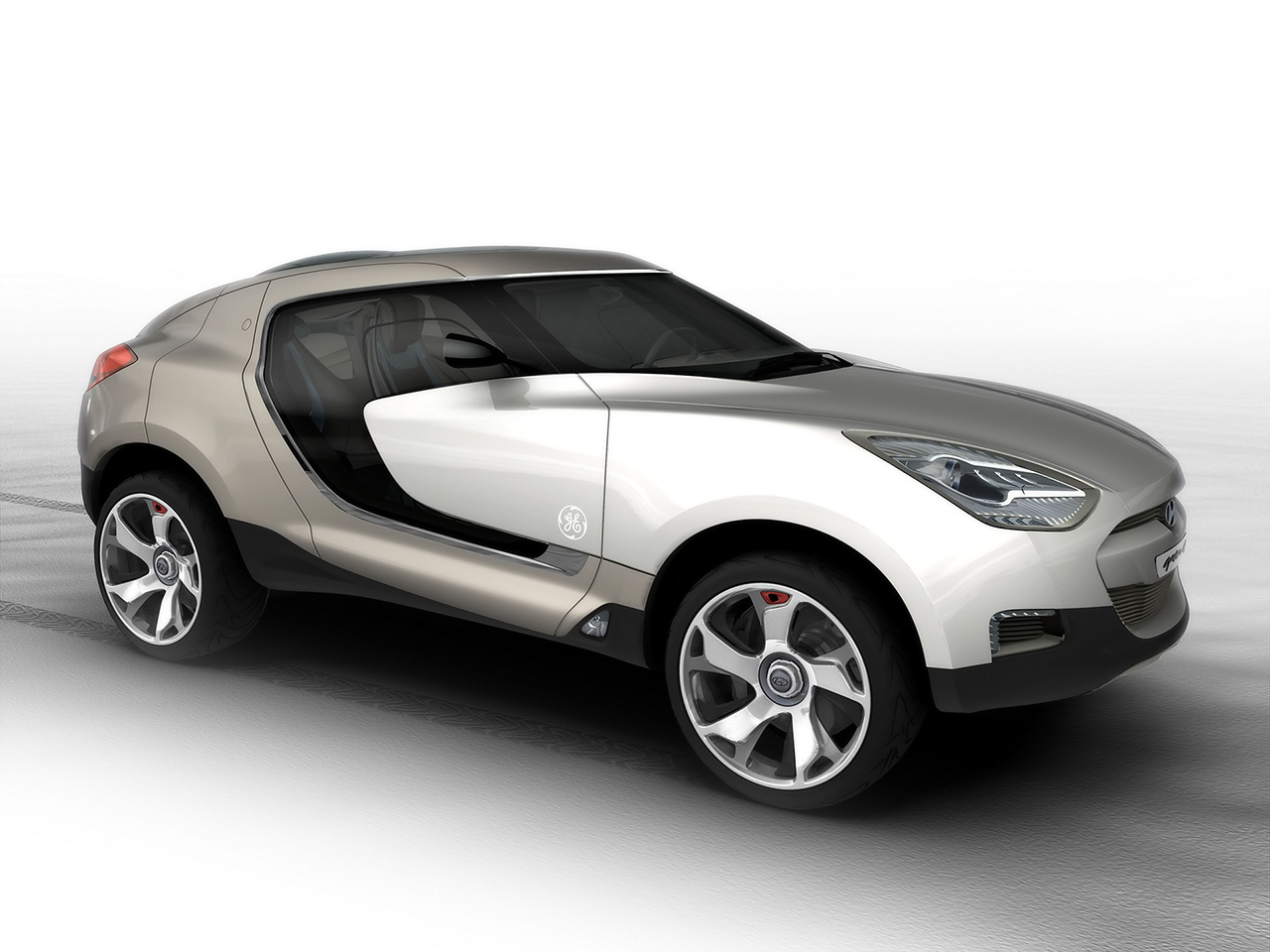2007 Hyundai QuarmaQ
|
Price |
-- |
Production |
-- | ||
|
Engine |
2 liter diesel |
Weight |
-- | ||
|
Aspiration |
-- |
Torque |
-- | ||
|
HP |
-- |
HP/Weight |
-- | ||
|
HP/Liter |
-- |
1/4 mile |
-- | ||
|
0-62 mph |
-- |
Top Speed |
-- |
(from Hyundai Press Release) Hyundai and GE Plastics Unveil QarmaQ Advanced Technology Demonstration Vehicle at 77th Geneva International Motor Show
Sporty Crossover Coupe makes debut in Europe
Elastic Front™ safety system reduces pedestrian injury
Eco-focused technologies lower weight, fuel consumption and CO2
At the Geneva International Motor Show today, Hyundai Motor Co. and
GE Plastics presented QarmaQ, a first in the Crossover Coupe
segment. QarmaQ is Hyundai's Advanced Technology Demonstration
Vehicle (ATDV) that showcases over 30 different environmentally
progressive technologies led by the innovative “Elastic Front™”, an
innovative solution that can help reduce the risk of severe injuries
in Crossover Utility Vehicles (CUV) pedestrian collisions.
Designed at Hyundai Motor Europe's Design and Technical Center in
Russelsheim and engineered in close cooperation with GE Plastics,
QarmaQ develops and validates over 30 key technologies, which will
be selectively incorporated into Hyundai’s new models to be rolled
out from 2008-2014.
“At Hyundai, we believe in innovation for humanity, and QarmaQ
demonstrates our commitment to safety innovation and our
determination to bring more environmentally responsible technologies
to the market,” said Dr. Kwon Moon-Shik, Hyundai Motor's vice
president of advanced technology. “We chose to partner with GE
Plastics because of their commitment to the environment and their
wide range of innovative materials and technical capabilities.
Technologies from QarmaQ will provide Hyundai owners with a safer,
more environmentally responsible car and a better driving
experience.”
QarmaQ is lighter, stronger and more economical than any current
production CUV in its class. It also offers significant recycling
advantages both in construction and eventual disassembly. In short,
it is a viable and realistic glimpse of the future potential of
personal automotive transport.
Pedestrian Safety
The issue of pedestrian safety is a growing one. In the EU, one-fifth of all traffic fatalities – 7,000 people per year – are pedestrians hit by a vehicle. In densely populated Korea, the rate is as high as 39 percent. QarmaQ's Elastic Front™ safety system, which encompasses the whole front end of the vehicle, is arguably the world's first global pedestrian protection solution on a CUV. Three energy-absorbing structures are fully integrated underneath the futuristic styling of QarmaQ and this system takes advantage of several advanced materials that offer inherent energy absorbing properties. QarmaQ's body panels have been designed to work in concert with energy-absorbing systems on the underside of these panels to manage and dissipate the force of a pedestrian/CUV collision. The Elastic Front™ has been engineered to meet EEVC WG17 Phase2, Euro NCAP, and JNCA pedestrian impact requirements and is currently undergoing testing for final validation.
A totally relevant concept
The Hyundai QarmaQ concept car is the result of the fusion of
exceptional expertise and engineering foresight from Hyundai and GE
Plastics. More than a design concept, QarmaQ illustrates that
environmentally responsible solutions can be elegantly incorporated
to enhance safety, design and performance.
"GE Plastics is committed to developing greener, lighter and
aesthetically pleasing solutions to support our customers in
creating vehicles with reduced environmental impact," said Gregory
A. Adams, vice president and general manager, GE Plastics –
Automotive. "We are delighted to have collaborated with Hyundai and
we believe that working together we helped them develop an exciting
new CUV that demonstrates greater environmental responsibility as
well as improved safety, dramatic design, and high performance."
Firmly positioned as a crossover Coupe/CUV, the QarmaQ derives its
name from traditional Inuit dwellings, constructed from earth,
whalebone and animal skins. Like them, QarmaQ challenges
conventional ideas on construction methods and materials. Also in
common with the original structures, it boasts unusual strength,
resilience and protection.
By combining leading edge design, advanced engineering techniques
and the benefits of GE materials technology, the QarmaQ demonstrates
the ability to meet necessary, but problematic areas of legislation
dealing with pedestrian safety and eco-responsibility.
The choice of a crossover coupe/CUV format for QarmaQ underlines the
commitment of Hyundai to design innovation in this market sector.
With Santa Fe, Tucson, and Veracruz, Hyundai created pioneering
vehicles.
This 2+2 vehicle targets the important empty next baby boomers
demographic, who are rediscovering a new-found freedom while
remaining the wealthiest demographic in history. Today, this key
group of consumers is beginning to spend their nest egg and enjoy
the fruits of their labour, not on material possessions, but on
experiences. QarmaQ soulfully blends the driving experience of a
Coupe with the ability to manage multi-terrain driving of a CUV,
providing empty nesters with effortless access to their outdoor
playground.
Design: Freedom of shape
As a joint project with GE Plastics, QarmaQ endowed designers with
greater expressive freedom to create complex three-dimensional
shapes that could not have been achieved with conventional
production methods and materials such as metal and glass.
"The powerful profile and stance of the design incorporates dynamic,
sculptural qualities and elegant sportiness on one hand, with smooth
refined surfaces on the other," said Thomas Bürkle, chief designer,
Hyundai Motor Europe. "Moreover, the various properties of the GE
materials allowed more freedom in meeting or even exceeding safety
requirements. The result is a uniquely balanced and harmonic design
both inside and out," he added.
Departing from conventional car design that combines a lower body
and a glass cabin on top, QarmaQ blazes a new trail with panoramic
wrap-around glazing area using GE’s Lexan™ polycarbonate resin. This
part sits between the two pronounced “muscles” above the front and
rear wheels. The C-shaped side window enables innovative
helicopter-like downward visibility and is a key design feature
demonstrating the new glazing technology.
Exterior: Fluidity of line
Connected by unique glazed surfaces, the exterior design relates
strongly to, and interacts effortlessly with the interior. The
unique division between the solid bodywork and transparent glazed
areas creates a new perspective, whether viewed from inside or from
the pedestrian standpoint.
The exterior contours and fluidity of line have been refined to give
an immediate impression of movement frozen in motion. This aesthetic
is mirrored in the interior, so that the fusion and merging of the
perceptual boundaries between inside and out delivers a feeling of
integration and synchronization to the overall appearance.
Although QarmaQ does not have a high waistline or small window area
(conventional methods to convey a feeling of protection), the
exterior design still communicates a commanding presence and a
feeling of protection to the occupants.
"The QarmaQ’s exterior design communicates a commanding presence and
a feeling of protection to the occupants,” said Robert Butterfield,
global market director, GE Plastics. “ The twin domes on the
sunroof, facilitated by the new glazing technology, increases the
inner space for the rear passengers and creates a unique design
feature.” The wrap-around windscreen, in combination with the
elongated bonnet delivers dramatic, almost classic, proportions and
gives the car a unique sporty feeling. Finally, the contrast of the
strong dark coloured areas to the lighter tonal areas emphasizes
QarmaQ’s off-road DNA.
Interior
In response to shrinking family sizes and emergent customer
preferences, QarmaQ is specifically designed to carry four people in
above average comfort. The extensive use of new materials and
techniques has resulted in a more fluid, more unified interior, by
allowing seamless integration of otherwise intrusive elements.
As the sporting exterior proportions suggest, the QarmaQ is
primarily a driver’s car. Within its unique interior architecture
the cockpit is isolated in an active, yet protective pod structure.
This helps promote a sensorial and highly self-indulgent driving
experience.
One of the main aims of the interior design was to develop a
practical and interactive space, which wraps around the occupants.
The driver-oriented cockpit, which combines functionality with
organic sculpted shapes, creates an attractive, fun-to-drive
atmosphere. This is further underlined by:
The interior is brought alive by a variety of technologies, effects
and surfaces, including:
The colour harmony of the interior has been designed to enhance the
feeling of serenity and spaciousness, which in turn relates directly
to the high level of comfort enjoyed by the passengers. The mixed
effects, textures and colours add sophistication to the dynamic
forms and strong presence of the car. Functional elements made from
aluminium emphasise the more technical aspects, contrasting with and
highlighting the softness of the interior materials.
New materials, new directions in comfort and safety
Current composite technology is usually thought too expensive and
too difficult to fabricate to be of use anywhere but the aerospace
and motor racing industries. The QarmaQ is physical proof that this
need not be so.
The wrap-around GE Lexan™ windscreen and extensive use of GE
polycarbonate glazing materials provides a weight saving of up to 50
percent in relation to glass, while simultaneously allowing more
adventurous shapes than flat glass. The glazing features a unique
technology from Exatec™ which deposits a thin protective layer of
glass on the Lexan™ to add protection from scratching and the
effects of weathering.
QarmaQ also introduces new curved and moving side glazing in Lexan.
As well as allowing such advanced applications, the impact
resistance and other properties of this material also helps increase
both occupant and pedestrian safety.
Exatec™ infrared coatings on the whole transparent areas reflect
heat, helping cool the interior and reducing the power demands upon
the infrared regulated air conditioning. Lighting is achieved by
incorporating mood illumination into the actual material, delivering
a unique interior ambience. The material also facilitates a
perfectly flat, fully integrated fractal radio antenna within the
roof structure.
Among other milestones in the construction of QarmaQ, the front
wings were designed from the beginning to be one very large single
injection moulded component. Together with the deformable bonnet and
precise bumper mouldings, these also form a major addition to
pedestrian impact safety. The sophistication of the material and
manufacturing technique also played a major part in the ability to
fully encapsulate the complex headlight shape into the whole frontal
styling.
At the other end, the tailgate breaks new ground by bonding
different materials, including the glazing and rear light
assemblies, to create a one-piece component structure. This
increases the integral strength, while at the same time simplifying
vehicle assembly and reducing weight.
Another major safety advance is the use of sensors to detect vehicle
presence in the blind spots of the rear view mirrors when pulling
out or overtaking, and audio-visually alert the driver.
Euro5 diesel engine
QarmaQ's 2-liter diesel engine is fully compliant with EURO5 emission regulations. It features the very latest technologies such as high pressure fuel injection and fine fuel spray atomization for higher torque and better power output. Regulated emissions such as CO, THC, NOx and PM, were reduced drastically while a Catalyzed Particulate Filter system, CPF, is capable of cleaning about 90 percent of the particulate matter from the diesel emissions. Furthermore, by switching the position of CPF from the under-floor area to a location more closely coupled to the exhaust manifold, it was possible to minimize the catalytic light-off time and to enhance the naturally regenerative characteristics of the CPF.
A greener future
Thanks to extensive use of advanced materials, QarmaQ is 60 kg
lighter than a comparable vehicle made with traditional materials.
GreenOrder, an environmental strategy firm based in New York, N.Y.
that audited the Qarmaq estimated that the 60 kg. that have been
taken out of the Qarmaq, means the vehicle would require about 80
fewer litres of diesel per year, and would cut annual greenhouse gas
emissions by more than 200 kg. Furthermore, if every new vehicle
registered in the European Union (EU-15) in 2006 had reduced fuel
consumption by the same amount, the result would have been an annual
savings of more than 7.4 million barrels of diesel fuel -- or enough
to sustain the European Union (EU-15) diesel demand for three days.
As a result, the greenhouse gas savings would equal approximately
3.1 million metric tons of carbon dioxide. According to Joseph
Malcoun, an Associate with GreenOrder, cutting edge material
technologies are expected to make a major contribution to increasing
the fuel economy of tomorrow’s passenger vehicles. “As consumer
demand for more fuel efficient vehicles continues to grow, we expect
the use of advanced materials to play an increasing role in reducing
the greenhouse gas footprint of the cars we drive.”
HPPC composites for horizontal body panels significantly reduce part
weight - up to 50 percent per part - while maintaining strength
equal to that of steel. This lighter-weight cladding contributes to
better fuel efficiency and improved power-to-weight ratio for
drivers and its energy absorbing qualities are harnessed to create
the Elastic Front™ safety system.
QarmaQ's body panels use an environmental responsible plastic, Xenoy
iQ™ and Valox iQ developed as part of GEs ecomagination™ initiative
to address three critical environmental concerns: conserving energy,
lowering greenhouse gas emissions, and up-cycling or re-using
materials such as PET plastic bottles. QarmaQ re -uses approximately
900 PET bottles that would otherwise become landfill.
Another environmentally progressive aspect of the QarmaQ’s design is
the use of GE paint replacement technologies, including Visualfx™
resins with Lexan™ films, to replace painting operations that can
release toxic and greenhouse gases.
To eliminate dependency on PVC in the wiring, GE’s Noryl™ resin
technology was used for wire and cable coating. Replacing PVC, these
ultra-thin coatings can reduce cable weight by up to 25 percent.
About Hyundai Motor Co.
Established in 1967, Hyundai Motor Co. has grown into the
Hyundai-Kia Automotive Group which was ranked as the world’s sixth
largest automaker in 2005 and includes over two dozen auto-related
subsidiaries and affiliates. Employing over 68,000 people worldwide,
Hyundai Motor posted US$58.1 billion in sales in 2005 (on a
consolidated basis). Hyundai vehicles are sold in 193 countries
through some 5000 dealerships and showrooms. Further information
about Hyundai Motor Co. and its products is available at
http://www.hyundai-motor.com About GE Plastics GE Plastics
(www.geplastics.com) is a global supplier of plastic resins widely
used in automotive, healthcare, consumer electronics,
transportation, performance packaging, building & construction,
telecommunications, and optical media applications. The company
manufactures and compounds polycarbonate, ABS, SAN, ASA, PPE,
PC/ABS, PBT and PEI resins, as well as the LNP* line of
high-performance specialty compounds. GE Plastics, Specialty Film &
Sheet manufactures high-performance Lexan* sheet and film products
used in thousands of demanding applications worldwide. In addition,
GE Plastics’ dedicated Automotive organization is an experienced,
world-wide competitor, offering leading plastics solutions for five
key automotive segments: body panels and glazing; under the hood
applications; component; structures and interiors; and lighting. As
a Worldwide Partner of the Olympic Games, GE is the exclusive
provider of a wide range of innovative products and services that
are integral to a successful Games. For more information on GE’s
materials for automotive applications, please go to
www.geplastics.com.
*Valox, Xenoy, Noryl, Visualfx, ecomagination, LNP and Lexan are
trademarks of General Electric Company
*Exatec is a trademark of the GE joint venture, Exatec LLC
*Lumination, LLC is a subsidiary of GE Consumer & Industrial



